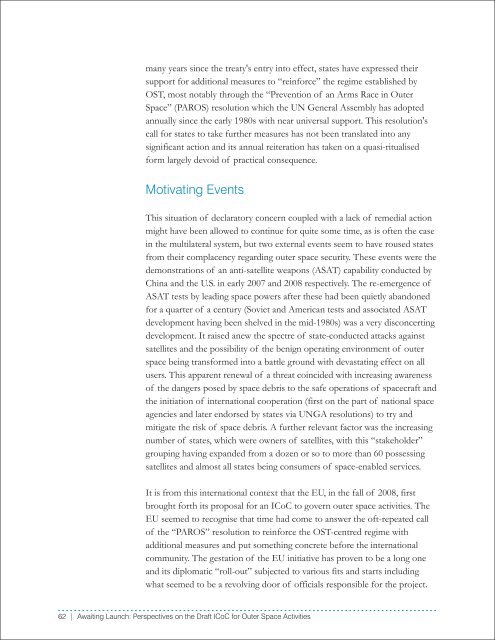AwaitingLaunch_1397728623369
AwaitingLaunch_1397728623369
AwaitingLaunch_1397728623369
You also want an ePaper? Increase the reach of your titles
YUMPU automatically turns print PDFs into web optimized ePapers that Google loves.
many years since the treaty's entry into effect, states have expressed their<br />
support for additional measures to “reinforce” the regime established by<br />
OST, most notably through the “Prevention of an Arms Race in Outer<br />
Space” (PAROS) resolution which the UN General Assembly has adopted<br />
annually since the early 1980s with near universal support. This resolution's<br />
call for states to take further measures has not been translated into any<br />
significant action and its annual reiteration has taken on a quasi-ritualised<br />
form largely devoid of practical consequence.<br />
Motivating Events<br />
This situation of declaratory concern coupled with a lack of remedial action<br />
might have been allowed to continue for quite some time, as is often the case<br />
in the multilateral system, but two external events seem to have roused states<br />
from their complacency regarding outer space security. These events were the<br />
demonstrations of an anti-satellite weapons (ASAT) capability conducted by<br />
China and the U.S. in early 2007 and 2008 respectively. The re-emergence of<br />
ASAT tests by leading space powers after these had been quietly abandoned<br />
for a quarter of a century (Soviet and American tests and associated ASAT<br />
development having been shelved in the mid-1980s) was a very disconcerting<br />
development. It raised anew the spectre of state-conducted attacks against<br />
satellites and the possibility of the benign operating environment of outer<br />
space being transformed into a battle ground with devastating effect on all<br />
users. This apparent renewal of a threat coincided with increasing awareness<br />
of the dangers posed by space debris to the safe operations of spacecraft and<br />
the initiation of international cooperation (first on the part of national space<br />
agencies and later endorsed by states via UNGA resolutions) to try and<br />
mitigate the risk of space debris. A further relevant factor was the increasing<br />
number of states, which were owners of satellites, with this “stakeholder”<br />
grouping having expanded from a dozen or so to more than 60 possessing<br />
satellites and almost all states being consumers of space-enabled services.<br />
It is from this international context that the EU, in the fall of 2008, first<br />
brought forth its proposal for an ICoC to govern outer space activities. The<br />
EU seemed to recognise that time had come to answer the oft-repeated call<br />
of the “PAROS” resolution to reinforce the OST-centred regime with<br />
additional measures and put something concrete before the international<br />
community. The gestation of the EU initiative has proven to be a long one<br />
and its diplomatic “roll-out” subjected to various fits and starts including<br />
what seemed to be a revolving door of officials responsible for the project.<br />
62 | Awaiting Launch: Perspectives on the Draft ICoC for Outer Space Activities








